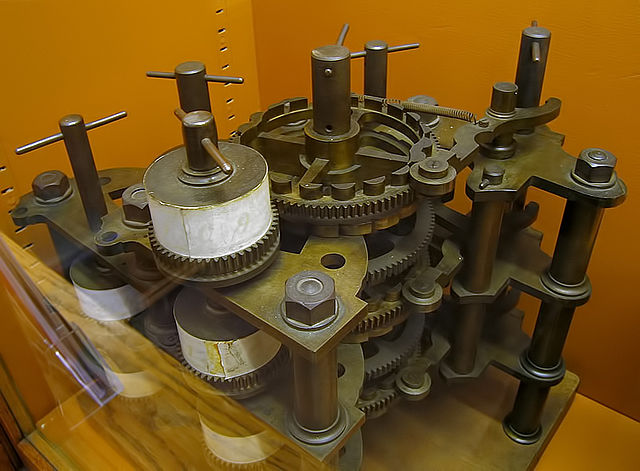 |
This is a file from the Wikimedia Commons. Information from its description page there is shown below.
Commons is a freely licensed media file repository. You can help.
|
Summary
| DescriptionBabbageDifferenceEngine.jpg |
Deutsch: Teil einer Differenzmaschine von Charles Babbage. Posthum aus Einzelteileilen aus dem Laboratorium zusammengesetzt durch seinen Sohn Henry Provost Babbage. Die Messingteile wurden vom Werkzeugmacher Joseph Clement hergestellt.
Henry Provost Babbage erbte die Einzelteile nach dem Tod seines Vaters 1871. 1879 baute er einige funktionfähige Abschnitte der Maschine zusammen. Höchstwahrscheinlich existieren sieben solche zusammengebauten Abschnitte.
Der abgebildete Abschnitt befindet sich im Whipple Museum of the History of Science der University of Cambridge und stellt dar, wie der Additions- und Übertragsmechanismus funktioniert. Die linke untere Seite des Fotos ist durch Reflektionen in der Glasscheibe der Ausstellungsvitrine nur schwer erkennbar.
English: Part of Charles Babbage's Difference Engine assembled after his death by Babbage's son, using parts found in his laboratory. The brass parts were machined by the toolmaker Joseph Clement. Babbage completed his difference engine, partly due to problems with friction and machining accuracy, but also because he kept changing the design. Henry Provost Babbage inherited the pieces following his father's death in 1871, and some years later in 1879 he assembled several working sections of the full machine. Possibly as many as seven assembled sections exist.
This portion, in the Whipple Museum of the History of Science of the University of Cambridge, demonstrates how the addition and carry mechanism works. In the photograph, part of the left hand side is obscured by reflections from the glass display case.
|
| Date |
6 November 2004 (original upload date to English Wikipedia) |
| Source |
Own work |
| Author |
Photograph © Andrew Dunn, 5 November 2004. Website: http://www.andrewdunnphoto.com/ |
Permission
( Reusing this file) |
CC-BY-SA-2.0
|
Licensing
File usage
The following pages on Schools Wikipedia link to this image (list may be incomplete):
This file contains additional information, probably added from the digital camera or scanner used to create or digitize it. If the file has been modified from its original state, some details may not fully reflect the modified file.


